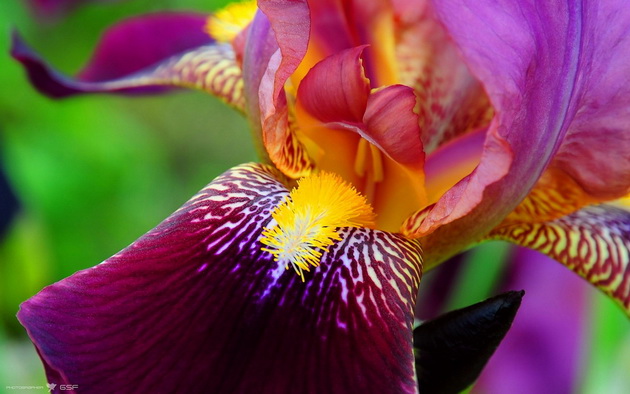Iris – How To Grow The Flower That Will Beautify Your Garden This Summer

Other than striking beauty and uniqueness, the iris has many symbolic meanings also.
In ancient Greece, this flower is tied to the goddess Iris and is somewhat of a personification of the rainbow. Purple irises were planted on the graves of girls to invoke the goddess to guide them in their afterlife journey.
During the Middle Ages, it is linked with the French monarchy and is a national and royal symbol, especially during the reign of Charlemagne.
In Japan it signifies the victory, and in Chinese art, it was the inspiration for the wings of butterflies and the colors of the rainbow. Iris was also tied with the fairies of the early summer.

There are more than 200 species of this beautiful flower, but the most common ones are those with blue and white dots. The flowering period starts in May and lasts until July,
Irises have numerous healing properties. All you need is 1 gr of powdered root of the iris in your daily diet as part of a meal or as a spice mixed in 200ml drinking water.
It helps with chronic inflammation of the stomach as well as urinary infections. It also soothes pain and it is very helpful for small children who are growing their first teeth.
Most importantly you can grow this perennial flower in your garden.
How to plant and grow iris
 Irises require a lot of sunlight and well-drained soil. Without enough sun, they won’t bloom. They lean toward neutral to slightly acidic soil. In the event that your soil is exceptionally acidic, sweeten it with a touch of lime, and avoid summer watering, which can prompt to decay.
Irises require a lot of sunlight and well-drained soil. Without enough sun, they won’t bloom. They lean toward neutral to slightly acidic soil. In the event that your soil is exceptionally acidic, sweeten it with a touch of lime, and avoid summer watering, which can prompt to decay.
Bearded irises thrive best in a special bed on their own. They have rhizomes (plump roots) that ought to be in part uncovered, or meagerly shrouded with soil in hot climates. Soil drainage is vital. Loosen the soil with a tiller or garden fork to a depth of 12 to 15 inches, then mix in a 2- to 4-inch layer of compost.
Plant iris in mid-to late summer. Plant rhizomes separately or in groups of three with the fans outermost, 1 to 2 feet apart, depending upon the size. Dig a shallow hole 10 inches in diameter and 4 inches deep. Make a ridge of soil down the middle and place the rhizome on the ridge, spreading roots down both sides. Fill the opening with soil and firm it delicately. Water altogether.
When planting, top-dress with a low-nitrogen compost, and again in early spring.
How to care for iris
 Avoid adding high-nitrogen composts to the surface or carelessly mulching with natural matter, which may cause rhizome decay.
Avoid adding high-nitrogen composts to the surface or carelessly mulching with natural matter, which may cause rhizome decay.
Keep rhizomes uncovered. Unlike bulbs, which flourish profound underground, iris rhizomes require a touch of sun and air to dry them out. If they’re covered with soil or swarmed by different plants, they’ll rot. Irises may profit by shallow mulching in the spring.
Try not to trim iris leaves. Leaves are vital for photosynthesis for next year’s new development. Cut off the brown tips and chop the blossoming stalk down to the rhizome to discourage rot.
If iris foliage is hit with heavy frost, expel and obliterate it to take out borer eggs.
After 2 to 5 years, when clumps get to be distinctly congested or lose vitality, separate and replant the healthy rhizomes in fresh soil. The best time to replant irises is not long after blossom. Transplant them to spots where they will have “wet feet yet dry knees.”


